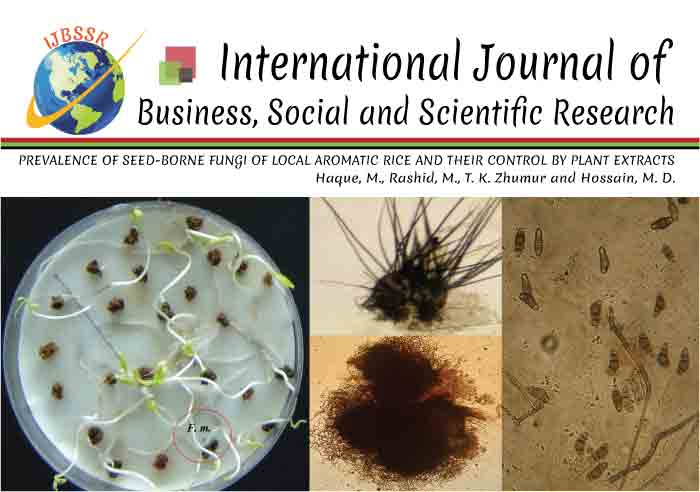DOI: http://doi.org/10.55706/ijbssr13101
The health status of three varieties of local aromatic rice (
Oryza sativa L.) seeds viz. Kalijira,
Tulshimala, and Chinigura were detected at the farmers' level and
collected from different locations of Gouripur Upazilla of Mymensingh district
of Bangladesh. Three hundred sixty-three seed-borne fungal infections were recorded
from 1500 seeds, representing 15 samples from five locations. This study
revealed that around 23% of the rice seeds were infected by several fungi, such
as
B. oryzae,
A.
padwickii,
C. lunata,
F. moniliforme,
F. emporium, and
A. niger. Among the fungi, the most predominant fungi were
F. oxysporum (22.3%), followed by
F. moniliform (16.6%),
A. flavus (14.87%),
A. padwickii (14.32%) and
A.
niger (14.8%). The
B. oryzae had
the lowest (9.3%) seed-borne infection. Germination of seeds of the three
selected aromatic rice varieties varied from 80.0-85.0%. The highest
germination was found in the Chinigura rice variety (85%), while the
lowest was in Kalijira. Seeds were treated with plant extracts,
viz.
neem, garlic and allamanda, with different doses to control the seed-borne
pathogen. In treated seeds, germination ranged from 84%-87%, and infections
were recorded at 0.95%-5.25%. Among the doses of all three plant extracts, 1:1
dilution showed significant performance in controlling seed-borne fungi and
increasing the germination of rice seeds. Among the extracts, garlic extract @
1:1 w/v was the best treatment for the per cent reduction of seed-borne
infection.

